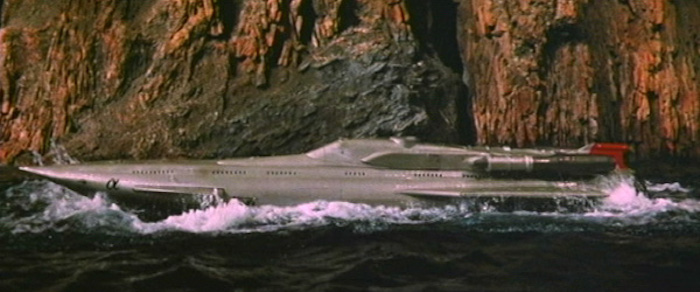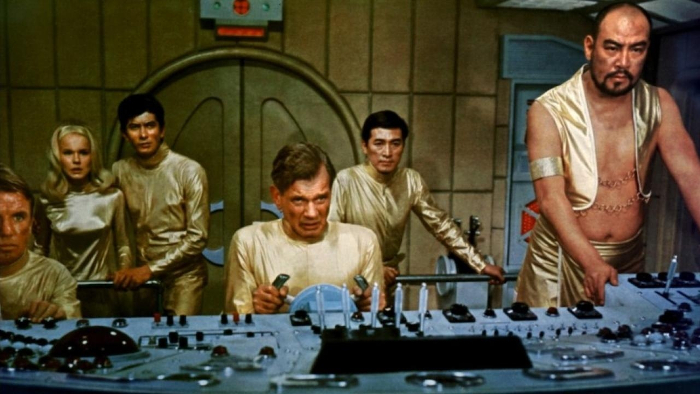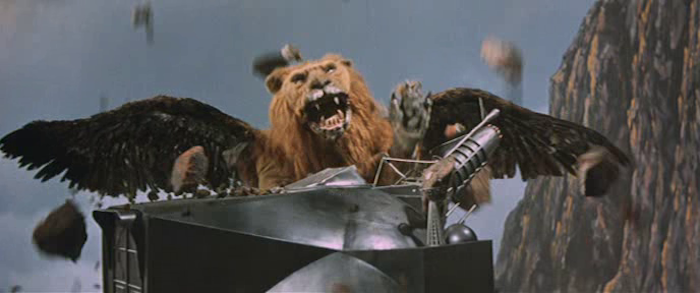Original title: Ido zero daisakusen
Latitude Zero is one of the least well remembered of director Ishiro Honda and effects supervisor Eiji Tsuburaya’s collaborations, a fruitful partnership that had given birth the kaiju eiga, or giant monster films that have proved popular in Japan and around the world ever since. It’s a strange hotchpotch – written by Americans, produced by the Japanese, shot in English, and full of tips of the hat to H.G. Wells, Jules Verne and kaiju films.
The script, written by Ted Sherdeman (writer of Them! (1954)) with additional dialogue from Warren Lewis (Shinichi Sekizawa handled the Japanese translation duties) has its roots in a 1941 radio serial written by Sherdeman and broadcast to great acclaim on NBC. The script found its way to Toho who agreed to co-produce the film with Don Sharp’s Four Star Productions in Hollywood but when Sharp unexpectedly filed for bankruptcy, Toho were left holding the proverbial baby and with production about to start had to find the rest of the budget themselves and press on regardless.

Oceanographer Dr Ken Tashiro (Akira Takarada) and geologist Dr Jules Masson (Masumi Okada) are joined by American photojournalist Perry Lawton (Richard Jaeckel) on a deep sea dive aboard a bathysphere. An undersea volcanic eruption leaves them stranded on the seabed with little hope of rescue until the futuristic submarine Alpha arrives captained by Craig McKenzie (Joseph Cotten). McKenzie is over 200 years old and the leader of a large deep-sea settlement known as Latitude Zero which is being menaced by mad scientist Dr Malic (Cesar Romero) and his own super-sub, the Black Shark, captained by Kuroi (Hikaru Kuroki). Malic has reasons for wanting Latitude Zero (we never really get the bottom of what those reasons are) and has been creating a race of genetically modified bats and rodents – when Koroi lets him down he has her brain transplanted into the body of a lion onto which he grafts bat wings. With Malic now holding nuclear physicist Dr Okada (Tetsu Nakamura) and his daughter Tsuruko (Mari Nakayama) hostage and preparing for his final attack on Latitude Zero, McKenzie and his surface-dwelling guests lead a final assault on his base.
Latitude Zero is more or less what you’d expect from a 60s Toho science fiction film/ The special effects range from the spectacular – the volcanic eruption that gets the story going is remarkable – to the ho-hum, the dialogue is dreadful, the model work variable, campy gold lamé costumes and of course there are monsters, though not of the giant, city-smashing variety this time. It’s not top-drawer Toho by a long stretch but it’s endearing enough and the action is fast and plentiful. It’s a long way from Tsuburaya’s usual standard and the effects wizard was nearing the end of his career – after Latitude Zero he would be credited on the non-genre Nihonkai daikaisen/Battle of the Japan Sea (1969) and Gojira-Minira-Gabara: Ōru Kaijū Daishingeki/All Monster’s Attack (1969) though the latter would be an in-name-only courtesy credit as he didn’t actually work on the film. He died the following year at the age of 68.

Latitude Zero is patently inspired by Jules Verne of course with McKenzie standing in for Nemo but in Malic’s hideous human experiments there are echoes of Well’s The Island of Dr Moreau though the resulting monstrosities are just men in terrible monster suits, as sorry a looking bunch of monsters as you’ll ever see. And as for the ridiculous lion/bat/human hybrid, a sort of artificial griffin with the brain of a psychopathic sidekick… In the pantheon of Japanese screen monsters, it’s one of the silliest, matched here only by a gaggle of giant rats so awful (they’re all too obviously just men in furry suits running around on all fours) that the much-derided super-rodent in the Doctor Who (1963-1989) serial The Talons of Weng-Chiang (1977) suddenly looks like the greatest special effect of all time by comparison.
The effects all round are something of a disappointment given Tsuburaya’s track record. The undersea utopia of Latitude Zero is nicely enough realised using a large diorama of elaborate miniatures but the monsters are just ludicrous and one suspect s that the film might have been a lot more fun without them. Certainly, in the climax, which takes on a James Bond feel, they seem superfluous to the action. The sight of our heroes clad in fetching golden jumpsuits, storming Malic’s lair on Blood Island using jetpacks (“elevation belts”) should have been enough and the appearance of the silly lion-thing is most unwelcome.

The cast are clearly up for having a bit of fun. Cotton – who brought his wife Patricia Medina along for the ride though she makes a less-than-convincing villain’s moll – treats the role like it’s serious drama but suffers from a particularly silly series of costume decisions (thigh length leather boots are popular among long-lived undersea adventurers it would seem). Casting Cesar Romero as the cape-wearing creator of a race of bat men feels like it must surely have been an in-joke given that he’d just finished his run as The Joker in the 60s Batman television series. Poor Linda Haynes, who turned 21 during production, is expected to play a doctor while mainly dressed in a bikini and seems lost a lot of the time and of the Japanese cast, many of who are obviously struggling with their phonetically learned English dialogue, Masumi Okda – a fluent English speaker – is most at ease. Richard Jaekel is the nominal hero and is likable enough but tends to be overshadowed by Cotton and Romero who are both great value for money in roles that could so easily just have been played for the highest of camp.
With its flying submarines, magnetic weapons and lasers it’s all exciting stuff and the “it might all have been a dream but was it?” ending is of a piece with the weirdness of the rest of the film. The whole thing is as mad as a box of frogs but so much lowbrow fun that it’s hard to not have a good time with it. Toho had already made a superficially similar film, Kaitei gunkan/Atragon, in 1963, but despite both films featuring highly advanced submarines they are completely unrelated.